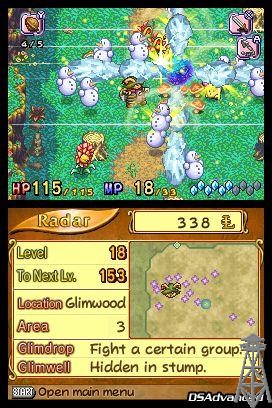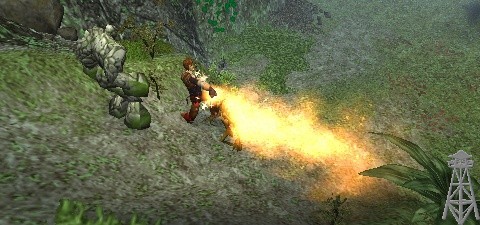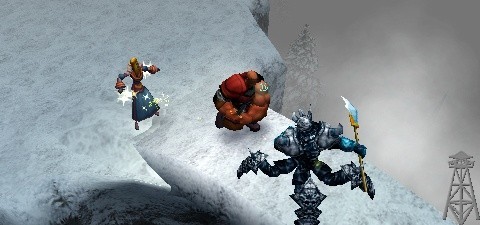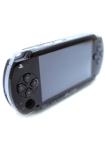The Whole Game in My Hand #2 - Dec. '06 / Jan. '07
Last month I discussed the state of handheld gaming during 2006 let you know which of this year’s handheld role-playing games are good, bad and indifferent. As of late December, the DS was still the overwhelming market leader in terms of system and software sales. The GBA was still a very viable platform, typically outselling the PSP on a monthly basis and producing some excellent titles in multiple genres. During the last two months there were three new RPG releases for the GBA, two for the DS and one for the PSP. That isn’t bad … until you realize that there were 19 GBA games, 33 DS games and 29 PSP games released in North America alone! This situation won’t improve any time soon – expect the ‘coming soon’ areas to be empty for a bit. In fact, the next time more than just a trickle of new handheld RPG’s will be released isn’t until March!
Looking at releases for just a month or two per article provides me another opportunity – I’ll be able to focus on providing a full review of one of the hot new RPG’s recently released. This month I am including a full review of Dungeon Siege: Throne of Agony for the PSP! Before we get to that, let’s see what else has been happening in the handheld role-playing world.
GameBoy Advance – November/December 2006 Releases
Three more gems … y’know, at some point the DS and PSP really will supersede the GBA as the RPG platform of choice. 2005 wasn’t that year … and 2006 won’t be either.
Final Fantasy V (Average Score 4/5, Rated E) OK, so this is just ‘yet another SNES port’. But unlike the derision that can easily carry for PS2-to-PSP ports, this one is a very welcome addition to the GBA lineup. This was the fifth game in Japan, but falls between the games called Final Fantasy II and III in North America. (Confused yet? Me too!) In fact, it was only released in the US as a dubious version on a Playstation compilation disc. The game isn’t a direct port of any existing version – rather it starts with the Japanese release, adds some of the best enhancements made for later versions, and features an all-new English translation of the original story and dialogue. Final Fantasy V is known for some gameplay and combat features that are still used heavily in new games, but not so much for the story and characters. The result is an excellent game that features some of the best gameplay of the series.
Summon Night: Swordcraft Story 2 (Average Score 4/5, Rated T) Despite coming just a few months after the initial game, there are plenty of differences in the story-driven action-RPG that focuses on crafting and skill-building. This sequel is better in almost every way, from graphics to story to the combat system. Another great GBA game, and one that I will review for my February article!
Yggdra Union (Average Score 4/5, Rated T) One of the most interesting and well done handheld RPG’s of 2005 was the surprising Riviera, a very stylish and innovative turn-based, character-driven game. Yggdra Union is a pseudo-sequel, and is very different game – this is a true strategy-RPG with card-based gameplay. It features excellent graphics and sound, as well as a deep and absolutely huge quest. The story isn’t as deep as Riviera, but the strategy elements are top notch, making this another great genre entry for the GBA.

GameBoy Advance – Coming Soon and Outlook
Based on the excellent success of Final Fantasy V this month, we are hotly anticipating Final Fantasy VI coming next year. There have been rumbling that Final Fantasy Tactics Advance will be getting a GBA sequel, which is excellent news. Despite a general slowdown of releases – and significant slowdown of new property for the platform, there looks to be plenty of great gaming coming for the GBA for quite a while.
Nintendo DS – November/December 2006 Releases
Quite a month … we have all three of these games going in my house – and they are all quite good!
Final Fantasy III (Average Score 4/5, Rated E-10) Truly an amazing feat – the excellent stories and characters from the original game that never got a North American release, totally re-imagined in 3D with an all new translation. Suffice it to say for now that this is a great game that you should buy if you have a DS – and that I will feature it for review next month!
Children of Mana (Average Score 3.5/5, Rated E-10) The beloved Mana series comes to the DS – but whether or not you’ll like it depends on how much you like dungeon crawlers! Taking a big side-step from the rest of the series, this game looks, sounds and plays great – but the story is necessarily thin due to the focus on exploration, combat and loading up on ‘phat l00t’! Interestingly, this will appeal more to fans of ‘western style’ action-RPG’s like Diablo than those looking for a sequel to the SNES classic Secret of Mana.
Pokemon Ranger (Average Score 3.5/5, Rated E) For a game that starts out looking like all you do is draw circles around moving targets, this is actually pretty good! You play as a Ranger, and your job is to capture wild Pokemon in an action-RPG that pits you against an evil band set to exploit the powers of Pokemon to do their bidding. This doesn’t have the depth or strategic elements of a typical Pokemon game (we have to wait until April for that), but is a solid game that is loads of fun.

Nintendo DS – Coming Soon and Outlook
While there are few games on the immediate horizon, next year is shaping up to be *huge* for RPG’s on the DS: Let’s start with the release of Final Fantasy Chrystal Chronicles, move to the latest addition to the Lunar series, and then on to the extremely major news that the next entry in the Dragon Quest series is coming to the DS. And that is just the start – the next ‘true’ Pokemon entries come to the DS in April, there are Final Fantasy XII and Tactics games coming , and more and more and more …
Sony PSP – November/December 2006 Releases
I love my PSP … but I hate the long load times, inadequate controls and often wonky camera systems put in place to get around the lousy controls. Oh, and I don’t like many of the games all that much … but I keep on trying, oh how I keep on trying. My latest attempt is a new property based on an existing PC series – Dungeon Siege.
Dungeon Siege: Throne of Agony (My Score 3.5/5, Rated T) Maybe I haven’t grown up, or maybe it is because I have two young boys – either way, a single word comes into my mind when I read the title ‘Throne of Agony’ … constipation. Read my GamerDad review and my full review at the end of the article!
Sony PSP – Coming Soon and Outlook
Well, the PSP has continued to be cursed by mediocre ports and games that seem like ports. That is true across genres - shooter fans get some PC shooter ports like Medal of Honor Heroes. This trend isn't helping the platform, since the ports seldom stand up well when compared to their PC or console brethren.
For next year, Crisis Core: Final Fantasy VII is shaping up to look and play great, and I’m totally stoked about Dungeons & Dragons Tactics and The Elder Scrolls Travels: Oblivion. Another Legend of Heroes game is set to launch in January … we’ll see how that goes.
Well, that is it for this month – next month I will look at Final Fantasy III in detail, as well as a quick view of whatever new releases sneak out between now and then. For now, enjoy my first in-depth review in this space, for a PSP game right out of the PC universe!
Review: Dungeon Siege Throne of Agony
The to-hit bonus for ported games being crap has to be something like +4 with a greatly extended critical range. So why should this game even be of interest? Because new content based on existing franchises has worked well on the PSP –as the Grand Theft Auto and Syphon Filter games have shown. Also, games like the two Untold Legends have demonstrated that an action-RPG is a near-perfect fit for the PSP hardware and controls. What those games lacked was a compelling reason to play – they featured generic characters, stories and combat, even by action-RPG standards. Dungeon Siege: Throne of Agony will not change any opinions you might have about deep stories in action-RPG’s, but it is a fun game that is the best handheld action-RPG yet and will keep you going for many hours if you can get past the limitations and issues.
I Am Wondering … Why Are You Here?
The story takes place in the Broken Lands, thereby sharing a common frame of reference with the recent PC expansion Dungeon Siege 2: Broken World (not the only commonality – more on that later). You end up stuck in the Broken Lands for reasons that depend on your character. Allistair is searching for his love, a Seeker who has gone after a powerful artifact; Mogrim is the last of his kind, yet after the Cataclysm feels drawn to the north as if going home; and Serin sees a need to strike back at the forces of evil while all of her people have been struck ‘blind’ in the Cataclysm. You board a boat together which crashes on the shores of the Savage Forest – and your adventure begins. All of this foreshadowing is done in a nice ‘graphic novel’ style that is very effective and much more interesting than the typical scaled-down CGI.
What you are really getting is a motivation more than a story – the world was broken in the Cataclysm, and there is much evil about trying to fill in the power void. You are given a solid character that has a purpose in this land – or thinks they do. You travel from town to town meeting leaders who need you to help them out in various ways – beating back hordes or evil, finding lost settlers, picking up dry-cleaning, and so on. After taking care of one area, you are given a bigger chunk of information about the ‘larger story’, which directs you on to the next area … and to the next quest-giver. It is just enough to keep you engaged while ensuring you aren’t ever lost by the pick-up-and-play nature of the PSP, but it is a fairly thin story – even compared to the PC Dungeon Siege games.
The layout of the world is significantly different in this game than other Dungeon Siege games – rather than a continuous world that you unfold a bit at a time, you enter ‘areas’ such as dungeons, then exit to the world map, where you run around from area to area.
You’re Such A Character
Dungeon Siege: Throne of agony allows you to choose from not one, not two, but THREE completely predefined and configured characters – that’s right, you’re the male fighter, male battle-mage or female rogue. I know – knock you over with a feather, right?!? Seriously, though, this isn’t as bad as it sounds – each character actually has their own back-story and motivation for venturing into the broken lands.
Not only that, each of the characters has a very individual combat style and set of companions that make fighting the same areas feel different for each one. Mogrim is a huge warrior with very powerful melee attacks, Allistair is a battlemage who can use melee weapons as well as powerful magic, and Serin is a dual-wielding rogue with some great speed attacks.
Aside from specialized skills and attacks, each player gets a companion – instead of recruiting party members, Dungeon Siege: Throne of Agony features summonable companions called ‘followers’. You select one after choosing a character – each character gets to choose from two, typically one focusing on melee and the other on ranged attacks and support. As you progress through the game you will meet several others, so that by the end you can have up to ten available followers. Simply summon them and they will appear at your side, and your current follower returns to their Pokeball or wherever they come from.
Character progression is a major aspect in most RPG’s and is prominently featured in Dungeon Siege: Throne of Agony. The three character types are already very distinct and offer a very different play experience, but the ability to tailor your specific character to a great degree allows you to customize your play experience. And because it is just you and a follower, the impact feels much greater than in the PC versions of the game. There are more skills than you will ever have skill points, so you need to actually think and plan on where to spend the points for maximum impact – going for a blanket approach will give you a broad set of low level skills … and a quick trip to an early death. Applying skills too narrowly will certainly find you focused on a single skill type (or element) that is completely ineffective against a certain boss – another recipe for a quick trip to an early death. The game provides an abundance of information here – just check out all of the possible skills, and see how the progression changes the skills, and you can start planning.
Tanks for Nuthin’
So I decided to play the Allistair the Battle Mage, and assumed that my level-up strategy would focus primarily on staying alive and casting more powerful magic, and secondarily on increasing my melee attacks. Based on that I chose the Stone Golem follower over the Lap Dragon – I was looking forward to watching the Golem lumber in and take out enemies while I toasted them with fireballs from the sidelines. Unfortunately it didn’t really work that way – every enemy focused all of their attacks on me, and the Golem had no initiative to go attack enemies until I made the first move. On the good side he could take loads of abuse, but on the bad side I ended up providing primary melee attacks as well as magic attacks to initiate melee – he was merely around to knock off some enemy hit points to make my job a bit easier.
Needless to say, I dumped him as soon as I could. I found a nice Druid in the middle of Act I who was very good act casting healing spells when I was at full health and putting herself into harms way to help me use up some resurrection Ankh’s that were over-filling my inventory. I stuck with her for a very long time because she would occasionally be very useful and was a better support system than any of the other followers I found.
Followers accumulate experience as your do – even if they are not active, but in that case they level-up more slowly. However, when they level up you can not simply allocate their points – their attribute points are automatically allocated, and you need to go to a scholar in town and pay to allocate their skills. As skills increase in level they increase in cost – but this isn’t much of a problem since you will have plenty of extra gold to spend. The biggest hassle is taking time to go to town to upgrade your followers.

Oh Yeah, I Forgot About That STORY Thing
Action-RPG’s by their very nature are more about a series of missions that end up telling a story rather than a true narrative. This is very much true in this game – you have a primary quest-giver who gives you missions as well as helping you unravel bits and pieces of the over-arching story a little at a time. Unfortunately, most of the time what you will hear is more like “thanks for finishing the quest, here’s your loot, blah blah blah, here’s another quest.”
The overall story is thin to the point that I actually got lost between quest-givers – it wasn’t clear that I was done with one section and that it was time to move on to the next area. This is partially due to the quest structure. You get quests, and occasionally can chose to accept or reject, but if you accept then you get a small description in your quest log.
The quest has a number associated with it – that number is the recommended player character level before tacking the quest. For example, I picked up an optional quest early on that was a ‘28’ when my Allistair was level 16! I knew it would be a while before I attempted that one! This quest-leveling is very helpful at helping you keep track of where you should be if you expect to successfully meet a challenge, but it has another effect – you become a slave to ‘the number’, constantly going back through areas to gain more experience and additional levels. You will also tend to get more experience by spending extra time in a dungeon since enemies respawn slowly over time. If you are in need of significant experience you can spend quite a while grinding out a level in a dungeon before tackling the next quest, and by the time you do start the quest you might not remember what you’re doing anymore.
I think I’ll Walk Instead
One of the great things in the Dungeon Siege games is the teleportation system. After exploring an area you can find and activate a teleporter, which allows you to quickly return to a town to sell off some loot or buy some potions before proceeding. What if I told you that in this game, getting from a dungeon entry to a teleporter not fifty feel away and teleporting to a city and walking to the vendor right beside the teleporter and then returning will take about five minutes – and that more than four of those minutes will be spent watching ‘now loading’ screens? Load times are a typical bane of the PSP fans existence, but these are particularly heinous, because they don’t seem bad at first. Thirty seconds here, thirty seconds there, fifteen seconds to wake up from sleep mode, ten seconds to load the main menu (yes, there is a loading screen for the menu) … none of these times are very long, but they start to stack up and become annoying.
This is exacerbated by other decisions and problems – the inventory system being chief among them. Your slots are very limited – and include items you have equipped. So if you can carry 35 things and have a total of 13 items equipped, including weapons armor and other stuff, then you only have ~20 slots remaining. Health and mana potions stack in inventory (only five per stack, though), but town portal scrolls and Ankhs don’t. So if you are going into a dangerous dungeon you can expect to have at least a dozen slots taken up by potions, scrolls and Ankhs. This forces you into a position of either constantly returning to town to sell stuff off or just skipping the loot. It was at this point I had my single positive memory of the Untold Legends game – in the first one you could learn a spell that would turn items to gold (at a lousy exchange rate, but still). I would have loved that option here.
Get A Little Closer – I Wanna Play Co-Op
One thing is certain about this type of game – it is the kind of experience people love to share. The best way to share this type of game is using online co-op multiplayer … something that Dungeon Siege: Throne of Agony doesn’t support. I have too few friends with PSP’s and even less time to play games in the same room with them, so all I got was a single half-hour session of co-op. This was just enough to tell me how excellent it would be exploring these dungeons with a thinking friend at my side rather than a ‘follower’. It also made it more frustrating every time I was struggling against a pack of foes and found my stone golem chatting up a rock on the sidelines.

The Lands Are Broken … What About The Game?
I had a load of fun playing Dungeon Siege Broken World, but was struck at every turn by how much better it could have been. There are other minor issues – the inventory system, repetitive combat and lack of intelligence of allies and enemies are the most notable – that plague the game, taking what is at times a truly excellent experience and making the end product frustratingly average. It is frustrating because it is clear while playing that this game could be so much better with a few tweaks to the gameplay and some significant load-time optimization.
Pros and Cons
+ Nice character customization system.
+ Solid combat system
+ Many hours of fun hack-n-slash on the go.
- Horrible load times attempt to ruin all the fun
- Thin story and repetitive play make progression a chore at times.
Final Score
I score this game as a solid 3/5. It is the best game of its genre on the PSP, yet it could have been much more. Expect ~15 – 20 hours for a single play through, more if you doggedly pursue level-equity with your quests.

Information about
#Handheld RPGDeveloper: Unknown
SP/MP: Unknown
Setting: Unknown
Genre: RPG
Combat: Unknown
Play-time: Unknown
Voice-acting: Unknown
Regions & platforms
Unknown
· Platform: Unknown
· To be announced
· Publisher: Unknown
More information
Other articles
- The Whole Game in My Hand #12 - Part 2: Sony PSP / Apple iPhone
- The Whole Game in My Hand #12 - Part 1: Nintendo DS
- The Whole Game in My Hand #11
- The Whole Game in My Hand #10
- The Whole Game in My Hand #9
- The Whole Game in My Hand #8
- The Whole Game in My Hand #7
- The Whole Game in My Hand #6
- The Whole Game in My Hand #5
- The Whole Game in My Hand #4 - March/ April '07
- The Whole Game in My Hand #3 - Feb. '07
- The Whole Game in My Hand #1 - November 2006

